
Screaming Lord Sutch was an English musician and perennial parliamentary candidate.
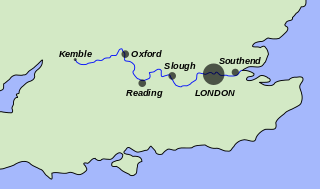
The River Thames, known alternatively in parts as the River Isis, is a river that flows through southern England including London. At 215 miles (346 km), it is the longest river entirely in England and the second-longest in the United Kingdom, after the River Severn.
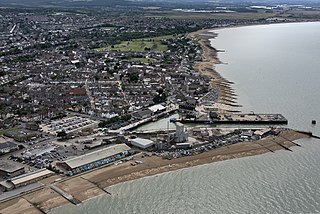
Whitstable is a town in the Canterbury district, on the north coast of Kent adjoining the convergence of the Swale Estuary and the Greater Thames Estuary in southeastern England, five miles north of Canterbury and two miles west of Herne Bay. The 2011 Census reported a population of 32,100.

Salcombe is a resort town in the South Hams district of Devon, south west England. The town is close to the mouth of the Kingsbridge Estuary, mostly built on the steep west side of the estuary. It lies within the South Devon Area of Outstanding Natural Beauty (AONB). The town's extensive waterfront and the naturally sheltered harbour formed by the estuary gave rise to its success as a boat and shipbuilding and sailing port and, in modern times, tourism especially in the form of pleasure boats and yachting. The town is also home to a traditional shellfish fishing industry. The town is part of the electoral ward of Salcombe and Malborough, for which the 2011 census recorded a total population of 3,353.
Pirate radio exists in most countries in Europe.
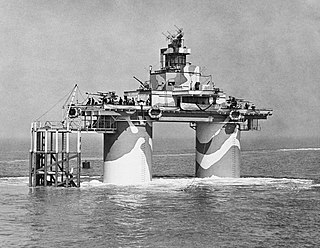
The Maunsell Forts are towers built in the Thames and Mersey estuaries during the Second World War to help defend the United Kingdom. They were operated as army and navy forts, and named for their designer, Guy Maunsell. The forts were decommissioned during the late 1950s and later used for other activities including pirate radio broadcasting. One of the forts is managed by the unrecognised Principality of Sealand; boats visit the remaining forts occasionally, and a consortium named Project Redsands is planning to conserve the fort situated at Red Sands. The aesthetic attraction of the Maunsell forts has been considered to be associated with the aesthetics of decay, transience and nostalgia.

The Thames Estuary is where the River Thames meets the waters of the North Sea, in the south-east of Great Britain.
Guy Anson Maunsell was the British civil engineer responsible for the design of the Maunsell Forts used by the United Kingdom for the defence of the Thames and Mersey estuaries during World War II.
Pearce Reginald Hartley Calvert was an English artist manager, born in Huddersfield, Yorkshire, England.

HM Fort Roughs is one of several World War II installations that were designed by Guy Maunsell and known collectively as His Majesty's Forts or as Maunsell Sea Forts; the purpose of which was to guard the port of Harwich, Essex, and more broadly, the Thames estuary. This 4,500 ton artificial naval installation is similar in some respects to "fixed" offshore oil platforms. It is situated on Rough Sands, a sandbar located approximately 11 kilometres (6 nmi) from the coast of Suffolk and 13 kilometres (7 nmi) from the coast of Essex. Today it is the location and de facto capital of the unrecognised, self-proclaimed state of Sealand.

Radio City was a British pirate radio station broadcasting from Shivering Sands Army Fort, one of the abandoned Second World War Maunsell Sea Forts in the Thames Estuary.
Radio 390 (1965–1967) was a pirate radio station on Red Sands Fort,, a former Maunsell Fort on the Red Sands sandbar.

The Nore is a long bank of sand and silt running along the south-centre of the final narrowing of the Thames Estuary, England. Its south-west is the very narrow Nore Sand. Just short of the Nore's easternmost point where it fades into the channels it has a notable point once marked by a lightship on the line where the estuary of the Thames nominally becomes the North Sea. A lit buoy today stands on this often map-marked divisor: between Havengore Creek in east Essex and Warden Point on the Isle of Sheppey in Kent.
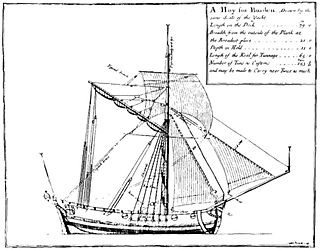
A hoy is a small sloop-rigged coasting ship or a heavy barge used for freight, usually with a burthen of about 60 tons (bm). The word derives from the Middle Dutch hoey. In 1495, one of the Paston Letters included the phrase, An hoye of Dorderycht, in such a way as to indicate that such contact was then no more than mildly unusual. The English term was first used on the Dutch Heude-ships that entered service with the Royal Navy.
The Black Deep is in the outer Thames Estuary. It is the greatest of three mainly natural shipping channels linking the Tideway to central zones of the North Sea without shoals, the others being the Barrow Deep and Princes Channel. Between these, a few others, and the shores of Kent, Suffolk and Essex are many long shoals in the North Sea, broadly shallow enough to wreck vessels of substantial draft at low tide.

Coastal defenceand coastal fortification are measures taken to provide protection against military attack at or near a coastline, for example, fortifications and coastal artillery. Because an invading enemy normally requires a port or harbour to sustain operations, such defences are usually concentrated around such facilities, or places where such facilities could be constructed. Coastal artillery fortifications generally followed the development of land fortifications, usually incorporating land defences; sometimes separate land defence forts were built to protect coastal forts. Through the middle 19th century, coastal forts could be bastion forts, star forts, polygonal forts, or sea forts, the first three types often with detached gun batteries called "water batteries". Coastal defence weapons throughout history were heavy naval guns or weapons based on them, often supplemented by lighter weapons. In the late 19th century separate batteries of coastal artillery replaced forts in some countries; in some areas these became widely separated geographically through the mid-20th century as weapon ranges increased. The amount of landward defence provided began to vary by country from the late 19th century; by 1900 new US forts almost totally neglected these defences. Booms were also usually part of a protected harbor's defences. In the middle 19th century underwater minefields and later controlled mines were often used, or stored in peacetime to be available in wartime. With the rise of the submarine threat at the beginning of the 20th century, anti-submarine nets were used extensively, usually added to boom defences, with major warships often being equipped with them through early World War I. In World War I railway artillery emerged and soon became part of coastal artillery in some countries; with railway artillery in coast defence some type of revolving mount had to be provided to allow tracking of fast-moving targets.

Patrick Roy Bates, self-styled as Prince Roy of Sealand, was a British pirate radio broadcaster and micronationalist, who founded the self-proclaimed Principality of Sealand.
This is a list of events from British radio in 1964.
'The Admiralty M-N Scheme' was a World War I British plan to close the Strait of Dover in the English Channel to German U-boats, by means of a chain of either eight or twelve massive towers linked by anti-submarine booms and nets. Only two towers had been constructed before the Armistice with Germany caused the cancellation of the project.
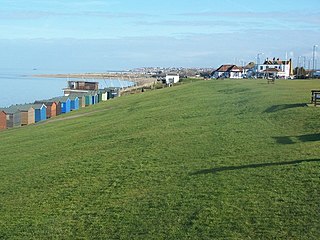
Tankerton Slopes is a 2.3-hectare (5.7-acre) biological Site of Special Scientific Interest in Whitstable in Kent. It is part of the Tankerton Slopes and Swalecliffe Special Area of Conservation















